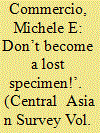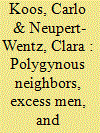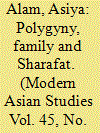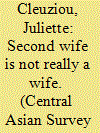|
|
|
Sort Order |
|
|
|
Items / Page
|
|
|
|
|
|
|
| Srl | Item |
| 1 |
ID:
173335


|
|
|
|
|
| Summary/Abstract |
Why would a woman agree to wed a legally married man when the state would neither recognize her marriage nor grant her alimony, child support or inheritance rights? Although the Communist Party curtailed the rate of openly acknowledged polygynous marriages among the Kyrgyz, its work was undone by glasnost and perestroika, which ushered in a permissive environment. This article highlights constructions of gender as a driver of polygyny in Kyrgyzstan from the perspective of women who voluntarily become second wives. The Kyrgyz case suggests that the cultural value of marriage and motherhood – traditions that grant women communal identities, power and prestige – might lead a woman to consent to second-wife status. I employ the concept of motivational interconnectivity, defined as two or more related reasons women make important personal decisions that have societal repercussions, to explain a woman’s decision to become a second wife.
|
|
|
|
|
|
|
|
|
|
|
|
|
|
|
|
| 2 |
ID:
173776


|
|
|
|
|
| Summary/Abstract |
We argue that polygyny creates a social imbalance where few, economically well-off men marry many wives and many poor men marry late or never. By definition, polygyny produces what we refer to as “excess men.” In order to gain material wealth, excess men are likely to raid, plunder, and rob neighboring ethnic groups. We test this hypothesis with georeferenced data on polygyny and intergroup conflict in rural Africa and find strong support. Drawing on Afrobarometer survey data, we explore the underlying mechanisms and find that young men who belong to polygynous groups feel that they are treated more unequally and are readier to use violence in comparison to those belonging to monogamous groups. Our article makes an important contribution to the peace, conflict, and development literature by emphasizing a fundamental aspect of human life: marriage and family.
|
|
|
|
|
|
|
|
|
|
|
|
|
|
|
|
| 3 |
ID:
105026


|
|
|
|
|
| Publication |
2011.
|
| Summary/Abstract |
While historians of South Asia have examined in elaborate detail critiques of sati and child marriage in the Hindu community, a similar approach to Muslim familial reform also needs serious attention. By investigating discourses on the question of polygyny, this paper is an attempt in this direction. In the light of these discourses, the paper argues that polygyny, influenced by modern sensibilities of reform and social change, underwent different interpretations during the colonial period. The debate on polygyny was not homogenous and uniform and research reveals a plurality of viewpoints on the subject. The argument was often based on an assumption of sexual difference which, in some cases, emphasized the infertility and reproductive incapacity of the first wife, and in others, presented an idealization of domestic ideology where the second wife made the 'perfect' home. Simultaneously, there were also strong critiques of polygyny by women writers who underscored the misery of the first wife. These debates do not necessarily settle the question in favour of a particular position, but reflect a conversation held on marriage, children and family, and express how love, conjugality and affection were narrated in the public sphere.
|
|
|
|
|
|
|
|
|
|
|
|
|
|
|
|
| 4 |
ID:
144163


|
|
|
|
|
| Summary/Abstract |
While polygyny in Tajikistan existed before the collapse of the Soviet Union in 1991 and has been a phenomenon of growing importance since Independence, it is still forbidden by law. To understand this renewal, I do not look at polygyny as a sign of religiousness, but as a form of patriarchal bargain in which women (who often experienced former matrimonial disjuncture) may have a greater power of decision in the spousal relations. I will explore women's points of view, from which polygyny is a strategy to accessing the symbolic and material resources they lack. I then explore the conditions to which becoming a second wife is possible: women's own resources, be they material, symbolic, familial, appear as of crucial importance in this accession to the status of being married anew.
|
|
|
|
|
|
|
|
|
|
|
|
|
|
|
|
|
|
|
|
|